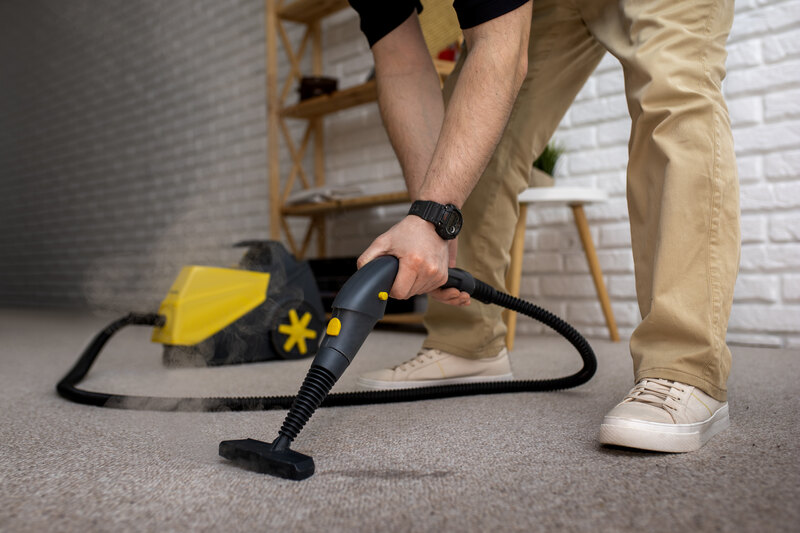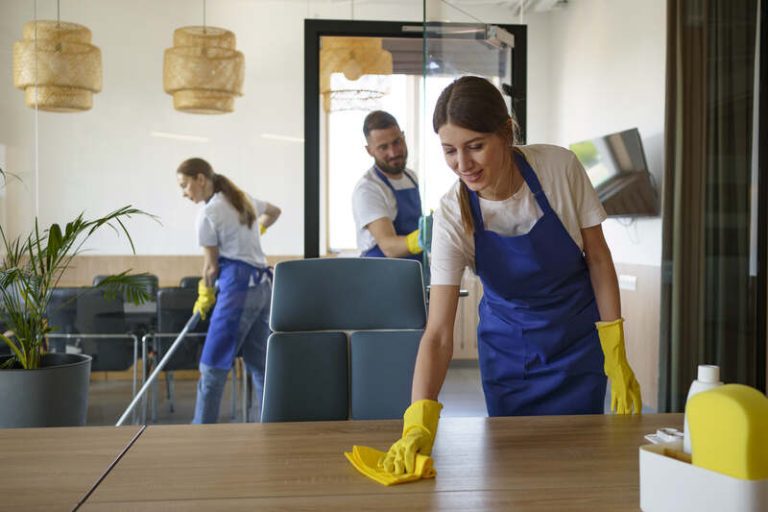Are your carpets in need of a deep clean but you’re not sure where to start? Well, if so, then this article on how to deep clean carpets is for you.
We discuss the importance of deep cleaning dirty carpets, the benefits it provide, and the different methods available.
Learn about the steps in deep carpet cleaning in-depth, effective cleaning tips, and common mistakes to avoid.
By the end of this article, you will have all the information you need to keep your carpets looking fresh and clean.
What Is Carpet Deep Cleaning?
Before going further into how to deep clean a carpet, first, let’s understand what deep carpet cleaning is.
Deep cleaning of carpets refers to a thorough and intensive cleaning process that goes beyond regular vacuuming or surface cleaning. It involves removing embedded dirt, stains, odours, and allergens from the carpet fibres, ensuring a cleaner and healthier environment within your home.
This meticulous process is essential in prolonging the lifespan of your carpets while maintaining their appearance. By eliminating deep-seated grime and bacteria, deep cleaning helps prevent health issues such as respiratory problems caused by allergens. It can revitalise the colours and texture of your carpet, enhancing the overall aesthetics of your living space. Various methods like hot water extraction, steam cleaning, and dry carpet cleaning are commonly used to achieve this thorough cleansing. Regular deep cleaning is necessary to not only maintain cleanliness but also to safeguard the indoor air quality of your home.
Why Is Deep Cleaning of Carpets Necessary?
In understanding how to deep clean carpets, you also have to know why it’s important to do so.
Thorough cleaning of carpets is necessary to eradicate stubborn stains, unpleasant odours, and harmful bacteria that may be lurking within the carpet fibres.
While regular hoovering helps maintain the surface cleanliness of the carpet, deep cleaning is crucial to reach the accumulated grime deep down.
Regular deep cleaning not only enhances the visual appeal of the carpets by restoring their original colours and texture but also plays a vital role in extending their lifespan. By eradicating stubborn stains effectively, deep cleaning prevents them from setting in and becoming permanent marks on the carpet, thereby preserving its overall condition.
What Are the Benefits of Deep Cleaning Carpets?
Deep cleaning carpets offers numerous benefits, including the removal of embedded dirt and stains, elimination of bacteria and allergens, improvement of indoor air quality, prolonging the carpet’s lifespan, and restoring its appearance to a like-new condition.
One of the most significant advantages of deep cleaning carpets is the thorough stain removal that it provides. By targeting deep-seated dirt and tough stains, this process can revitalise even the most soiled carpets.
The elimination of bacteria and allergens not only creates a healthier indoor environment but also contributes to reducing potential health risks. Deep cleaning helps in enhancing the durability of carpets, preventing premature wear and tear, and ultimately extending their longevity.
Therefore, understanding how to deep clean carpets is not only useful for keeping them clean, but more than that.
How Often Should You Deep Clean Your Carpets?
The frequency of deep cleaning carpets depends on various factors such as footfall, presence of pets, allergies, and spills. In general, it is recommended to deep clean carpets at least once every 12 to 18 months to maintain optimal cleanliness and hygiene.
Certain situations may require more frequent deep cleaning sessions. For instance, households with heavy footfall or pets may benefit from a deep cleaning every 6 to 12 months to remove embedded dirt and pet dander effectively. If someone in the household suffers from allergies or respiratory issues, more frequent carpet cleaning may be necessary to improve indoor air quality and reduce allergen levels. It’s essential to monitor the carpet’s condition regularly and look out for signs like persistent odours, visible stains, or increased allergy symptoms to determine when a deep cleaning is needed.
The Different Methods of Deep Cleaning Carpets
There are several methods available for deep cleaning carpets, including hot water extraction, dry cleaning, shampooing, and bonnet cleaning. Each method has its unique approach to removing dirt, stains, and contaminants from carpets effectively.
Hot water extraction, also known as steam cleaning, is a popular method that involves spraying hot water with a cleaning solution onto the carpet and then extracting the water along with the dirt and grime using a powerful vacuum.
Dry cleaning, on the other hand, uses specialised cleaning powders or foams that are applied to the carpet, agitated, and then vacuumed away, leaving behind a clean and dry carpet surface.
Shampooing is a traditional carpet cleaning technique that involves applying a foamy shampoo solution to the carpet, scrubbing it in, and then extracting the dirty solution.
Bonnet Cleaning utilises a carpet cleaning machine with an absorbent pad that rotates and agitates the carpet fibres to absorb dirt and stains.
So, what is the best method for deep cleaning carpets? Then the answer will depend on preference, here’s a further explanation of how to deep clean carpets.
a. Hot Water Extraction
Hot water extraction is a popular method for deep cleaning carpets that involves using hot water and a cleaning solution to loosen and extract dirt and debris from the carpet fibres.
This method is effective in removing deep-seated stains and allergens, leaving the carpet clean and refreshed.
The process of hot water extraction typically begins with the pre-treatment of the carpet with a specialised cleaning solution that penetrates the fibres to break down stubborn stains and dirt.
Next, a high-powered machine injects hot water mixed with the cleaning solution into the carpet and immediately extracts it, along with the dislodged dirt and grime, using a powerful vacuum.
This method not only cleans the surface but also reaches deep into the carpet pile, ensuring a thorough and effective cleaning process.
b. Dry Cleaning
Dry cleaning is a carpet cleaning method that uses minimal moisture and specialised cleaning agents to lift dirt and stains from the carpet fibres. This approach is ideal for delicate carpets or situations where minimal drying time is required.
One of the key benefits of dry cleaning is that it is a gentle yet effective method for removing tough stains without causing damage to the carpet fibres. The specialised cleaning agents used in the process are designed to break down and lift dirt and grime without saturating the carpet with water, making it suitable for carpets that cannot withstand traditional wet cleaning methods.
Dry cleaning is particularly well-suited for delicate fibres such as wool or silk, as these materials can shrink or lose their shape when exposed to excess moisture. By using minimal water, this method ensures that the carpet retains its original texture and appearance while still achieving a thorough cleaning.
c. Shampooing
Shampooing carpets involves applying a specialised cleaning solution to the carpet, agitating it to loosen dirt and stains, and then extracting the solution along with the debris. This method is effective in deep cleaning and revitalising carpets, especially in high-traffic areas.
When shampooing carpets, professionals often utilise powerful carpet cleaning machines that inject the cleaning solution deep into the fibres. The equipment’s brushes or rotary pads effectively agitate the stains, ensuring a thorough cleaning. After allowing the solution to dwell and work its magic, the next step involves the extraction process, where the dirt-laden solution is removed, leaving behind fresh, clean carpets. Revitalising carpets through this method not only improves their appearance but also enhances indoor air quality by eliminating allergens and bacteria.
c. Bonnet Cleaning
Bonnet cleaning is a surface cleaning method that involves using a rotating bonnet pad soaked in a cleaning solution to absorb dirt and stains from the carpet surface. This method is quick and effective for maintaining the carpet’s appearance between deep cleaning sessions.
One of the key benefits of bonnet cleaning is its ability to provide a quick solution for light cleaning needs. Its efficiency lies in the rotating bonnet pad mechanism, which ensures thorough dirt absorption without excessive moisture reaching the carpet fibres.
The equipment used for bonnet cleaning typically includes a floor machine with a drive block to attach the bonnet pad. The cleaning solution is usually a mild detergent solution that is sprayed onto the bonnet pad before starting the cleaning process.
This method is particularly suitable for carpets that require surface cleaning and spot treatments rather than deep extraction cleaning. It is a convenient option for regular maintenance to keep carpets looking clean and fresh.
Steps for Deep Cleaning Carpets
To fully understand how to deep clean carpets yourself, it’s important to know the detailed steps.
Deep cleaning of carpets involves several essential steps to ensure thorough cleaning and restoration of the carpet’s appearance. These include pre-vacuuming, pre-treating stains, applying a cleaning solution, agitating the carpet fibres, extracting the solution, and drying the carpet completely.
Pre-vacuuming is crucial as it helps remove surface dirt and debris, allowing the cleaning solution to penetrate deeply. Pre-treating stains beforehand ensures better removal during the cleaning process.
The application of a quality cleaning solution is key to breaking down stubborn dirt and grime. Agitating the carpet fibres helps loosen embedded dirt for more effective extraction. Proper extraction of the cleaning solution is vital to prevent residue buildup. Thorough drying is essential to prevent mould and mildew growth.
a. Pre-vacuuming
Pre-vacuuming is an essential first step in deep cleaning carpets, as it helps remove loose dirt, dust, and debris from the carpet surface. This process prepares the carpet for deeper cleaning methods and ensures that embedded dirt is effectively targeted.
By taking the time to pre-vacuum before deep cleaning, you are not only enhancing the appearance of your carpet but also prolonging its lifespan. Removing surface debris before applying cleaning solutions allows for a more thorough and effective cleaning process. Pre-vacuuming can help prevent the spread of dirt and allergens during the deep cleaning process, ensuring a healthier environment for you and your family. This initial step sets the stage for a successful and comprehensive cleaning experience, leaving your carpets looking fresh and revitalised.
b. Pre-treating Stains
Pre-treating stains involves applying a cleaning solution or spot treatment to specific areas of the carpet where stains or spills are present. This step helps break down the stain particles and prepares them for more effective removal during the deep cleaning process.
Depending on the type of stain, different solutions are used to target specific components of the discolouration. For example, grease stains may require a degreasing agent, while protein-based stains like blood or urine may need an enzyme-based solution. The application of these solutions can vary, from spraying directly on the affected area to using a cloth soaked in the treatment. These pre-treatment steps are crucial in loosening the stains’ grip on the carpet fibres, making them easier to lift off during the cleaning process.
c. Applying Cleaning Solution
Applying a cleaning solution to the carpet fibres is a crucial step in deep cleaning, as it helps break down dirt, grime, and stains trapped within the fibres. The cleaning solution is typically sprayed or spread evenly across the carpet surface for maximum coverage.
Ensuring an even application of the cleaning solution is vital to target all areas of the carpet uniformly and allow for effective grime breakdown. As the solution penetrates the fibres, it works to loosen embedded dirt, making it easier for the extraction process. This pre-treatment step plays a significant role in preparing the carpet for thorough cleaning, ensuring that dirt and stains are lifted efficiently during the extraction process.
d. Agitating the Carpet
Agitating the carpet fibres after applying the cleaning solution helps further loosen dirt, debris, and stains from the carpet surface. This step enhances the cleaning process’s effectiveness by ensuring that embedded particles are dislodged for easier extraction.
By agitating the carpet, you allow the cleaning solution to penetrate deeper into the fibres, reaching dirt and grime that may be firmly attached. This process essentially helps to break the bond between the dirt and the carpet, making it easier to remove during the extraction phase. Fibre agitation is crucial as it ensures that the cleaning solution reaches all areas of the carpet, leaving no stubborn stains behind. The act of agitating the carpet not only improves the overall cleaning results but also helps restore the carpet’s appearance and prolong its lifespan.
e. Extracting the Cleaning Solution
Extracting the cleaning solution from the carpet involves using specialised equipment such as a carpet extractor or wet vacuum to remove the dissolved dirt, grime, and stains from the carpet fibres. This step ensures thorough cleaning and prevents residue buildup.
These machines work by injecting a mixture of water and cleaning solution deep into the carpet pile. The powerful suction then extracts the solution, along with dislodged debris, leaving the carpet refreshed and spotless. The residue removal capability of these devices is crucial in achieving a deep clean, as it ensures that no cleaning agents are left behind to attract more dirt. Carpet extractors and wet vacuums play a pivotal role in maintaining carpets, keeping them free of contaminants and looking their best.
f. Drying the Carpet
Drying the carpet completely after deep cleaning is essential to prevent mould growth, musty odours, and residual dampness. Proper air circulation and low humidity levels help expedite the drying process, ensuring that the carpet is ready for use within a reasonable timeframe.
One effective way to enhance the drying process is to utilise fans or open windows to promote air circulation.
Constant airflow aids in evaporating moisture trapped within the carpet fibres, speeding up the overall drying time.
Placing humidifiers in the room helps maintain optimal humidity levels, preventing excess moisture that can lead to mould formation.
Tips for Effective Deep Cleaning of Carpets
For effective deep cleaning of carpets, consider vacuuming regularly, addressing stains promptly, using the right cleaning products, testing solutions in inconspicuous areas, following the manufacturer’s instructions, and investing in professional cleaning equipment for thorough results.
When dealing with stubborn stains, it’s crucial to act quickly and tackle them using the appropriate stain-removal techniques. Stain removal products such as enzymatic cleaners or oxygen-based solutions can be highly effective in breaking down tough spots.
Additionally, cleaning product selection plays a significant role in the overall outcome. Opt for products that are specifically formulated for carpets to ensure safe and efficient cleaning without causing damage.
When using new cleaning solutions, it’s advisable to test them in inconspicuous areas first to avoid potential discolouration or adverse reactions with the carpet fibres.
Common Mistakes to Avoid When Deep Cleaning Carpets
When deep cleaning carpets, avoid common mistakes such as over-wetting the carpet, using excessive cleaning solution, scrubbing vigorously, neglecting proper drying, and skipping pre-treatment steps. These errors can lead to carpet damage, mould growth, and ineffective cleaning results.
Overwetting the carpet can not only take longer to dry, but it can also seep into the carpet pad, causing potential mould and mildew issues over time. Using an excessive amount of cleaning solution may leave residue behind, attracting more dirt and grime, and ultimately making the carpet dirtier faster. Scrubbing too vigorously can damage the carpet fibres and fade colours, jeopardising the overall appearance and longevity of the carpet.
Tips for Maintaining Your Carpet After Deep Cleaning
After deep cleaning your carpets, maintain their cleanliness by implementing regular vacuuming, spot cleaning spills promptly, using area rugs in high-traffic areas, avoiding outdoor shoes indoors, and scheduling professional deep cleanings periodically to prolong the carpet’s lifespan.
Regular vacuuming is crucial to remove dirt and debris, preventing them from settling deep into the carpet fibres. Make sure to vacuum in different directions to lift embedded particles effectively.
When spills occur, act quickly by blotting, not rubbing, the area with a clean cloth and using a mild cleaning solution.
Placing area rugs in high-traffic zones can shield the carpet from excessive wear. Encourage family members and guests to remove their shoes at the door to minimise dirt and stains from entering your home.
Adhere to a consistent schedule for professional deep cleanings to address deep-seated dirt and allergens.
There you have it, a full explanation of how to deep clean carpets that you can do. Although it can vary depending on the level of dirt and stains, deep carpet cleaning often takes a long time.
Therefore, look no further than a trusted professional carpet cleaning service like TEKA Cleaning. With our commitment to excellence and attention to detail, we offer unparalleled carpet cleaning solutions that ensure your carpets are not only clean but also maintain their quality and extend their lifespan.
Utilising the latest cleaning technology and methods, including our partnership with Karcher for state-of-the-art equipment, TEKA Cleaning guarantees a deep clean that traditional DIY methods simply cannot match. Whether it’s removing stubborn stains, eliminating deep-seated dirt, or addressing wear and tear, our team of skilled technicians is equipped to handle all your carpet cleaning needs.
Choosing TEKA Cleaning means opting for a healthier home environment, free from allergens and pollutants that can accumulate in your carpets over time. Trust us to restore your carpets to their former glory, ensuring they remain a valuable and beautiful part of your home for years to come.
Don’t let the task of deep cleaning your carpets overwhelm you. Book now or give us a call on 01233 751 544 and let TEKA Cleaning take care of the hard work. Experience the difference professional carpet cleaning can make in your home or business. Contact us today to schedule your carpet cleaning appointment and enjoy the peace of mind that comes with knowing your carpets are in expert hands.
Read also:










